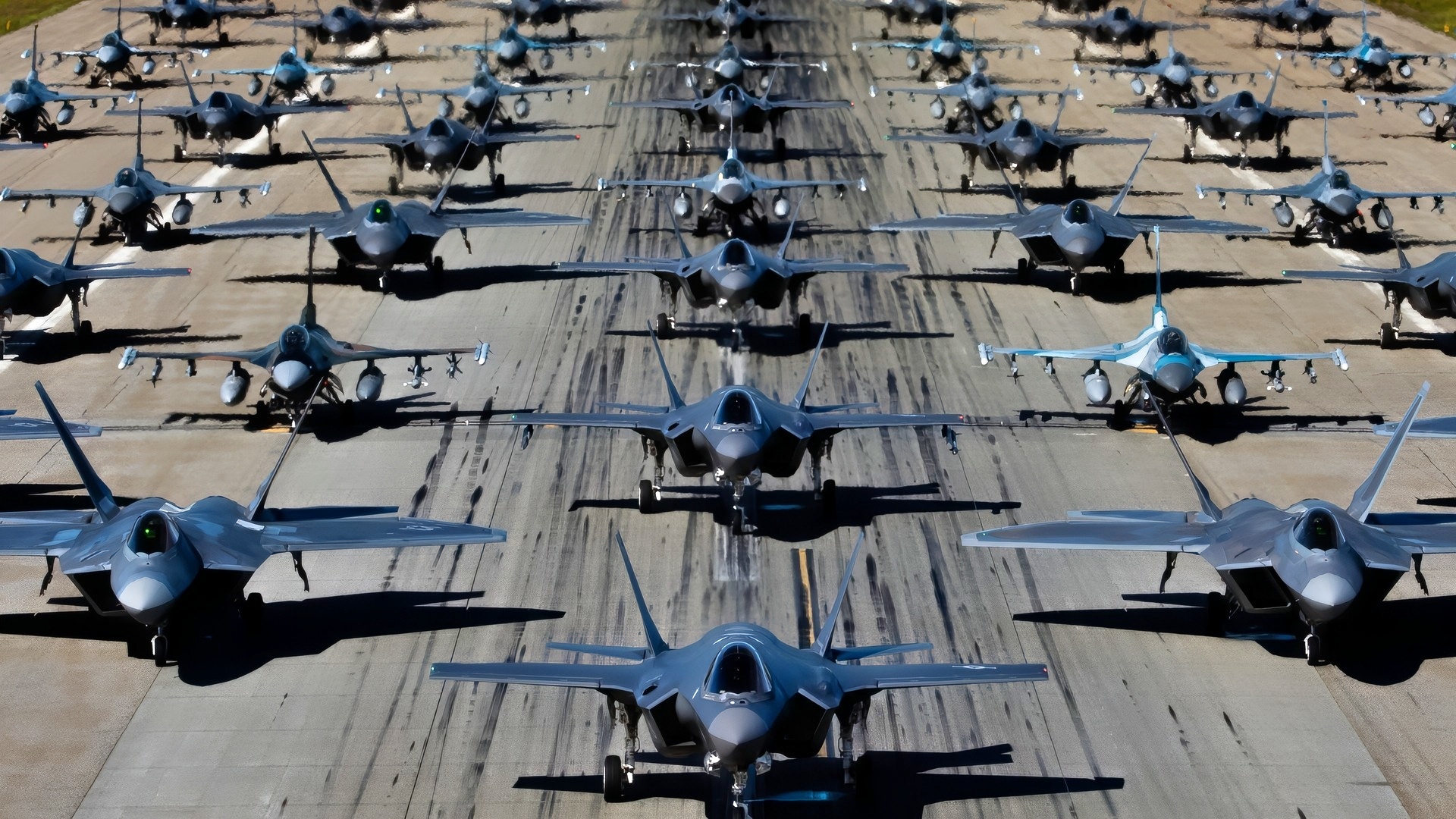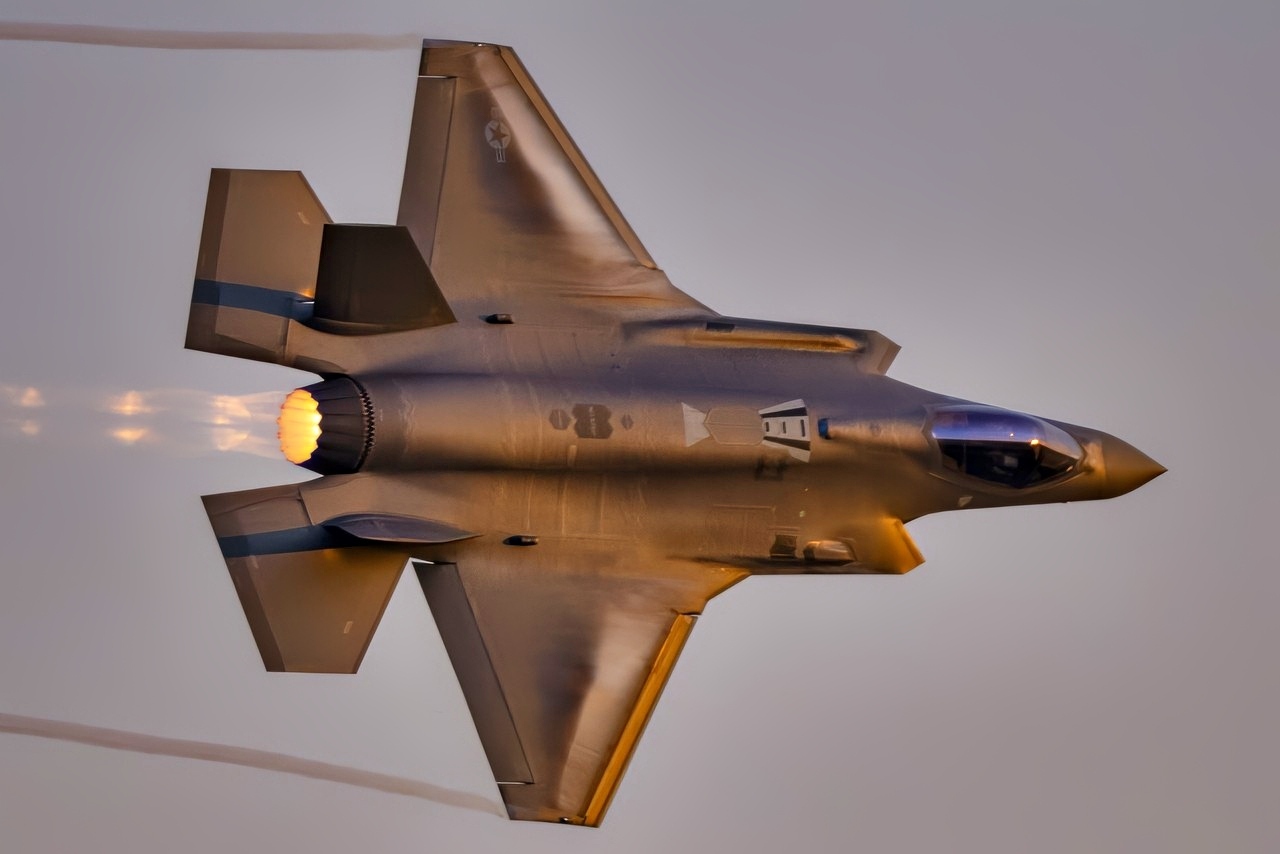Key Points and Summary – The F-35A Lightning II has been certified to deliver the B61-12 nuclear gravity bomb, transforming America’s premier 5th-generation fighter into a strategic deterrent.
-Stealth, terrain-masking, and internal carriage let the jet approach at low altitude with reduced detection, complementing legacy bomber options.

The 354th Fighter Wing conducts a 75-fighter jet formation at Eielson Air Force Base, Alaska, Aug. 12, 2022, in honor of the U.S. Air Force’s 75th Anniversary. This capabilities demonstration included F-35A Lightning II, F-16 Fighting Falcon and F-22 Raptor aircraft from across Pacific Air Forces. (U.S. Air Force photo by Senior Airman Gary Hilton)
-The B61-12’s guided tailkit (variable yields up to ~50 kt) adds precision while preserving flexibility for NATO host nations.
-Allies including the U.K. and Germany plan integration, expanding non-strategic nuclear options as Russia fields large tactical stockpiles.
-With tests completed and units trained, the F-35A brings a fast, survivable nuclear delivery path that complicates adversary planning.
The F-35A Now Has the Nuclear Option
You quickly recognize that the F-35 Lightning II is a tactical and even an operational-level warplane. The stealthy fighter jet is capable of evading radar, firing conventional standoff weapons in a multi-threat environment, eliminating adversarial aircraft at close range, and returning home safely.
But you may not know that the F-35 is now certified to drop nuclear weapons. The Lightning II has become a strategic asset that enhances the efficacy of the US nuclear triad, which has relied on much larger stealth and conventional bombers for decades. The nuclear-capable F-35 will be an even more lethal instrument of war that has the United States in a better strategic position as the jet serves into the 2040s.
The B61-12 Nuclear Gravity Bomb Is a Tactical Weapon
The F-35 will carry the B61-12 thermonuclear gravity bomb, which is highly accurate and destructive. The F-35 is a perfect delivery mechanism for a short-range, tactical weapon that can buy time for the United States military to prepare for a follow-on strike from ICBMs if needed. It’s a welcome development as the Americans work on the Golden Dome missile defense shield to protect the country from an enemy nuclear strike with an ICBM.
The Dual-Threat Nature of the F-35
The F-35 was always envisioned as a dual-threat airplane that could make adversaries stand up and take notice with its potential ability to deliver nuclear weapons. The strategic option for tactical aircraft is something that the Americans were interested in when developing the F-35.
The radar evasion component and high speed of the fifth-generation F-35 make it a supersonic option that can fly much faster and be increasingly difficult to shoot down compared to the non-stealthy and slower B-52 and B-1B.
“The F-35A is the first 5th generation nuclear capable aircraft ever, and the first new platform (fighter or bomber) to achieve this status since the early 1990s. This F-35 Nuclear Certification effort culminates 10+ years of intense effort across the nuclear enterprise, which consists of 16 different government and industry stakeholders,” F-35 Joint Program Office spokesman Russ Goemaere said. “The F-35A achieved Nuclear Certification ahead of schedule, providing U.S. and NATO with a critical capability that supports US extended deterrence commitments earlier than anticipated.”
Keeping Putin From Executing the Worst Case Scenario
Older B-61 nuclear bombs are housed in Europe with some NATO partners, but there hasn’t been a significant stealth fighter delivery system like the F-35 in the weapons’ history. The B61-12 is the most modern version of the battlefield nuclear weapon.
As Vladimir Putin becomes more belligerent in Europe, there could be a potential NATO-Russia nuclear exchange. Putin is not above rattling nuclear sabers and could one day test his own tactical nuclear weapon to show the world he is always ready to do the unthinkable.
The British and Germans also want to go with the B61-12 nuclear bombs on their F-35s. This means that NATO could have the advantage in non-strategic nuclear weapons dropped from the dual-capable Joint Strike Fighter. B61-12s are stored in Belgium, Germany, the Netherlands, Italy, and Turkey.
More Details About the B61-12
The B61-12 is the 12th version of the free-fall thermonuclear weapon. This is an 826-pound bomb with GPS inertial guidance with a life extension program. The explosive force will be between 0.3 and 50 kilotons. The United States currently possesses a total of 680 B61s, including 230 for non-strategic assets such as fighter jets. There is also the B61-13, an updated model in development, that could deploy an explosive load of 360 kilotons.
The B61-12 has a length of 12 feet. The bomb uses ballistic gravity or guided drop modes. There is a tail-kit guidance system, and it has an accuracy of 30 meters. The B61-12 is “equipped with four maneuverable fins, the tail section offers high levels of accuracy and limited standoff capability over the previous variants,” according to AirForce-Technology.com.
The Lightning II will carry this weapon internally, allowing for stealth when flying to the target. The device was tested in 2023 at the Tonopah Test Range with F-35 fighters from the 422nd and 59th Test and Evaluation Squadrons, based at Nellis Air Force Base, Nevada.
Low-flying and Rapid Nuclear Strike from the Fifth Generation Fighter
The B61-12 also needs to be dropped from a lower altitude, and the F-35 is perfect for this role. The B-52 and B-1B often must fly at much higher altitudes for a nuclear strike with other standoff nuclear-tipped cruise missiles.
The F-35 will be able to get closer to targets compared to bombs dropped from B-1Bs and B-52s due to the Lightning II’s radar evasion. Fourth-generation airplanes, such as the F-15E Strike Eagle and F-16C/D Fighting Falcon, can execute the dual-capable role and carry the B61-12, but they are not stealthy.
The pairing of the F-35 with the B61-12 is a valuable development for the United States and its NATO allies. The nuclear scenario is more of a realistic outcome in 21st-century warfare, with no end in sight to the Russo-Ukraine war. The Russians are also currently sending aircraft to encroach on the airspace of NATO members and can likely drop their own nuclear gravity bombs.
This is a dangerous development. President Donald Trump said on September 23 that the Europeans should shoot down Russian airplanes that fly in the friendly airspace of NATO members. It is unclear how Putin would respond to such an outcome, but this could lead to further rhetoric that threatens a nuclear exchange.
Russia has approximately 2,000 tactical nuclear weapons in its arsenal. The United States and its allies must be able to respond to deter Russia’s potential use, thereby keeping Moscow from attacking first. The F-35 capability will make Putin think twice about a first-use non-strategic strike on the battlefield.
About the Author: Brent M. Eastwood
Brent M. Eastwood, PhD is the author of Don’t Turn Your Back On the World: a Conservative Foreign Policy and Humans, Machines, and Data: Future Trends in Warfare plus two other books. Brent was the founder and CEO of a tech firm that predicted world events using artificial intelligence. He served as a legislative fellow for US Senator Tim Scott and advised the senator on defense and foreign policy issues. He has taught at American University, George Washington University, and George Mason University. Brent is a former US Army Infantry officer. He can be followed on X @BMEastwood.
More Military
Mach 2.65 F-111 ‘Aardvark’ Strike Fighter Has a Message for the U.S. Military
Russia’s MiG-29 Fulcrum Fighter Has a Message for NATO
The X-40A Space Plane Has a Message for the U.S. Military
The Mach 6.7 X-15 Space Plane Has a Message for the U.S. Air Force











Pingback: USS Abraham Lincoln (CVN-72): One of the Best U.S. Navy Aircraft Carriers Ever - National Security Journal